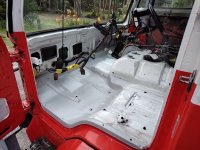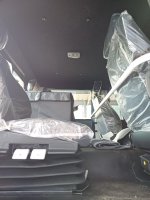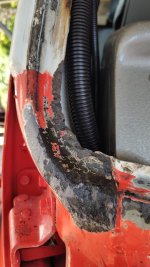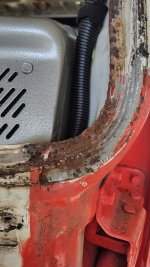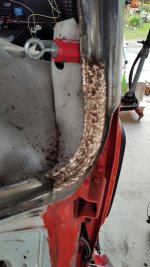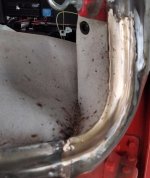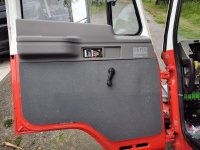Paint:
The blue paint on the cab is Toyota Cavalry Blue (8W2) tinted Raptor Liner. The Blue paint on the house is almost Cavalry Blue Haymes 307 Iso Free Acrylic Polyurethane.
Both paints were applied with a LVLP gun with a 2mm nozzle/air cap.
The roof is Haymes Iso Free Acrylic Polyurethane in white.
A few tips for those that want to use Raptor with a normal paint gun. Use a gravity fed gun, and use the maximum thinner, don't mess around just do it. Raptor is really variable with humidity and temperature, so pick your timing and make sure you can get a full coat done without more than 5 degrees temperature variation. Otherwise you will have to change your gun settings and supply pressures. There is a little bit of variation of texture on the cab from this, but I had to do a third coat to get rid of some literal rough patches.
Some tips for using the Haymes 307 product. Use a 1.4 or 1.7 tip. 2 is too large. Don't paint in the wind. The result in a confined space (ie paint booth) with a fine-medium tip and appropriately thinned paint is really good as an industrial finish. It isn't automotive quality finish, but i don't care, I wanted an industrial type finish. The paint is hardy and hard. It doesn't do well over flexible joints or seam sealer. It cracks and flakes. I'll have to work out what to do in the gutters on the roof because it has cracked badly as the gutters are full of seam sealer. I did a full epoxy coat under the seam sealer, so I'm not worried about it yet. But I will have to fix it.
I generally use PPG paints, so it was interesting to see the differences in these two. I think the Haymes makes a great solution for a fast curing, hardy coating for general use. There is no isocyanate and this means you can use it outside a booth with care ( it is still full of toluene and other stuff that is bad for you, so treat it accordingly).
The Raptor Liner is really easy to use, and their helpline is actually helpful. I don't like that their promo videos down play the hazard of the isocyanate and don't give industry standard direction as to how to be safe while using it. If you are going to play with it use an external air fed respirator in line with your local laws. Don't spray it up wind from your neighbours, and don't release the waste into the environment or pour it down any drains.
We've had the raptor liner crack in a couple of spots too. These have generally occurred on edges of the sheet metal where something has pushed against the edge. Otherwise it has performed well to date. With the texture from the LVLP gun we can hose it or wipe it down and is easy to take care of.
Let me know if you have any questions.
The blue paint on the cab is Toyota Cavalry Blue (8W2) tinted Raptor Liner. The Blue paint on the house is almost Cavalry Blue Haymes 307 Iso Free Acrylic Polyurethane.
Both paints were applied with a LVLP gun with a 2mm nozzle/air cap.
The roof is Haymes Iso Free Acrylic Polyurethane in white.
A few tips for those that want to use Raptor with a normal paint gun. Use a gravity fed gun, and use the maximum thinner, don't mess around just do it. Raptor is really variable with humidity and temperature, so pick your timing and make sure you can get a full coat done without more than 5 degrees temperature variation. Otherwise you will have to change your gun settings and supply pressures. There is a little bit of variation of texture on the cab from this, but I had to do a third coat to get rid of some literal rough patches.
Some tips for using the Haymes 307 product. Use a 1.4 or 1.7 tip. 2 is too large. Don't paint in the wind. The result in a confined space (ie paint booth) with a fine-medium tip and appropriately thinned paint is really good as an industrial finish. It isn't automotive quality finish, but i don't care, I wanted an industrial type finish. The paint is hardy and hard. It doesn't do well over flexible joints or seam sealer. It cracks and flakes. I'll have to work out what to do in the gutters on the roof because it has cracked badly as the gutters are full of seam sealer. I did a full epoxy coat under the seam sealer, so I'm not worried about it yet. But I will have to fix it.
I generally use PPG paints, so it was interesting to see the differences in these two. I think the Haymes makes a great solution for a fast curing, hardy coating for general use. There is no isocyanate and this means you can use it outside a booth with care ( it is still full of toluene and other stuff that is bad for you, so treat it accordingly).
The Raptor Liner is really easy to use, and their helpline is actually helpful. I don't like that their promo videos down play the hazard of the isocyanate and don't give industry standard direction as to how to be safe while using it. If you are going to play with it use an external air fed respirator in line with your local laws. Don't spray it up wind from your neighbours, and don't release the waste into the environment or pour it down any drains.
We've had the raptor liner crack in a couple of spots too. These have generally occurred on edges of the sheet metal where something has pushed against the edge. Otherwise it has performed well to date. With the texture from the LVLP gun we can hose it or wipe it down and is easy to take care of.
Let me know if you have any questions.

